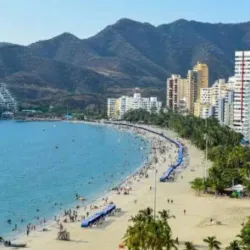Crime and Pollution in Santa Marta
The following data and statistics on crime, pollution, and overall safety in Santa Marta are derived from a combination of trusted public sources and insights gathered from over 27 user contributions.
This comprehensive approach helps provide a balanced view of the city's crime rates, environmental concerns, air quality, and public safety. By aggregating information from government reports, environmental studies, and direct feedback from residents, we aim offer an up-to-date and thorough analysis of key factors impacting quality of life in Santa Marta.
Crime Data in Santa Marta
Crime Perception and Concerns
In 2024, Santa Marta’s crime statistics reflect a moderate level of crime, stirring a complex mix of concern and adaptation among its residents. Despite issues with crime, some elements of community safety persist.
There is a marked contrast between the perceived safety during daylight, where people feel more secure, and the heightened concerns at night.
Some notable concerns include:
- Property Crimes - Property crimes, while not at the forefront of Santa Marta's crime concerns, still present issues that residents face. The fear of theft, particularly car-related thefts, is subdued, but vigilance remains necessary.
- Drug-Related Issues - Drug-related crimes, although not the leading concern, contribute to the public’s apprehension about the safety of certain neighborhoods and their potential impact on community wellbeing.
- Violent Crimes - Concerns about violent crimes are significant, with residents expressing fear of being mugged or robbed. This has created a cautious approach to navigating the city, particularly after dark.
- Public Safety - During daylight hours, a noticeable portion of the population feels reasonably safe. However, feelings of security diminish considerably at night, with many people cautious of violent crimes and mugging.
Crime Trends and Safety
- Rising Crime Concerns - There is a pervasive belief that crime is on the rise, further exacerbated by corruption issues, which undermine efforts to maintain law and order in the city.
- Specific Fears - While property crime fears are moderate, there's a pronounced concern regarding corruption and bribery that impacts the trust in local institutions. There is an impressively low concern about being targeted due to skin color, ethnicity, or religion.
Summary of Crime in Santa Marta
Santa Marta continues to battle moderate crime levels with focused efforts needed to combat rising crime perceptions and systemic corruption. Enhancing public safety and reducing fear of violent crimes will improve community trust and wellbeing.
Crime Rankings
The crime ranking by city for Colombia is based on a continuously updated index, incorporating data up to 36 months old and calculated twice a year. Cities are ranked on a scale from "very low" to "very high" crime levels, with safety being the inverse, where a high safety index indicates a safer city.
Pollution Data in Santa Marta
Air Quality and Pollution Levels
Santa Marta faces significant challenges with pollution, marked by a high pollution index. The air quality reflects moderate concerns, impacted by urban emissions that affect health conditions.
Pollution concerns, especially particulate matter levels, are at the forefront of environmental discussions, highlighting the need for actionable strategies to mitigate their effects.
- PM2.5 (Fine Particulate Matter) - The PM2.5 levels are above optimal health standards, posing notable risks to vulnerable groups, suggesting an urgent need for air quality management strategies.
- PM10 (Coarse Particulate Matter) - PM10 levels in Santa Marta contribute heavily to pollution concerns. These higher levels are indicative of the dense urban activities and require consistent governmental interventions.
Waste and Noise Pollution
Garbage disposal issues are a pronounced dissatisfaction point for residents, significantly affecting perceptions of cleanliness and quality of life.
Noise and light pollution, although less impactful than other pollution issues, still contribute to the discomforts of urban living in Santa Marta.
- Garbage Disposal Satisfaction - There is a striking dissatisfaction with garbage disposal systems, reflecting a broader concern about waste management efficacy and neighborhood upkeep.
- Noise and Light Pollution - Noise pollution rates indicate moderate concerns, compounded by the constant hum of city life and inadequate urban planning around the flow of night-time activities.
Green Spaces and Water Quality
Santa Marta's green spaces are critically undervalued, with a need for improvement and rehabilitation to increase their beneficial usage.
Drinking water quality is crucially lacking, impacting residents’ daily life and highlighting significant areas for infrastructure improvement.
- Green and Parks Quality - The quality of green spaces and parks is perceived negatively, a challenge that hinders community recreation and environmental health.
- Drinking Water Quality - Drinking water quality and accessibility present significant concerns in Santa Marta, pointing to dire needs for improvements to ensure safe and reliable water supply.
Pollution Rankings
The pollution ranking for Colombia is based on a combination of visitor perceptions and data from institutions like the World Health Organization. The Pollution Index estimates overall pollution levels by considering air and water pollution, garbage disposal, and other factors, with air pollution given the highest weight, while the Pollution Exp Scale uses an exponential function to highlight extremely polluted cities.
"Key Takeaways"
Santa Marta grapples with moderate crime focused around violent threat areas and corruption, severely impacting public trust.
Pollution issues, particularly with air quality and waste management, remain concerning, with a negative perception of green spaces and severe drinking water challenges.
Through concentrated efforts in urban planning, waste management, and community safety, Santa Marta can leverage its strengths to address its crime and pollution challenges.












